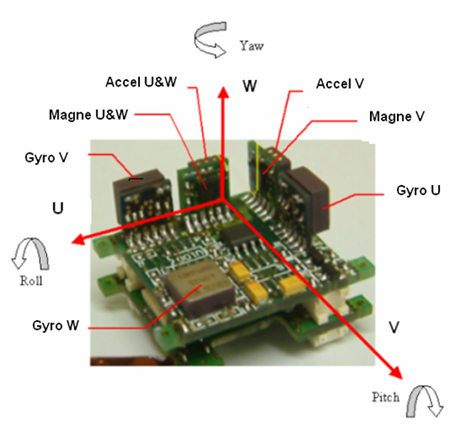by John Barton, Brian Caulfield & Niall Moyna
The increasing availability of cheap, robust and deployable sensor technology will usher in a new wave of ubiquitous information sources. A particular implementation of ambient sensors is in the area of wearable electronics in body area networks incorporating inertial sensing devices. As part of the CLARITY Centre for Sensor Web Technologies, the Tyndall Wireless Inertial Measurement Unit (WIMU) is being used in a number of projects focussing on two key themes: Health and Fitness, and Helping the Aged.
Wireless Inertial Measurement Unit
The Tyndall Wireless Inertial Measurement Unit (WIMU) is a 6 Degrees of Freedom (6DOF) inertial sensing device, comprising triple-axis accelero-meters, gyroscopes (angular velocity) and magnetometers. The triple-axis acceleration and angular velocity sensor output values can be combined in a nonlinear matrix equation to give both position and orientation information. The system can be visualized by using a fixed frame of reference for position measurement (x, y, z), the Earth-Fixed Frame, and utilizing a moving non-inertial frame (u, v, w), the IMU-Fixed Frame, which has its axes parallel to those of the IMU sensors.
The 25mm WIMU was developed based upon Tyndall's 25mm modular wireless sensor node technology. It is one of a large family of layers currently available for the Tyndall25. The 25mm wireless node has been used to develop a platform for low-volume prototyping and research in the wireless sensor network domain. A number of research projects currently underway at the institute are using it as a platform for sensing and actuating in scalable, reconfigurable distributed autonomous sensing networks, and it is supported by Science Foundation Ireland (SFI) through Tyndall's National Access Program (NAP).

Inertial Sensing for Health and Fitness
The development of unobtrusive sensing elements embedded in the fabric of garments has opened countless possibilities for the innocuous monitoring of athletes over extended periods of time in a variety of sport settings. Foster Miller (an independent company but part of the QinetiQ Inc. group) has recently developed a T-shirt-based Ambulatory Physiological Monitoring System, which monitors the vital signs of a person during activity and transmits the data wirelessly to a remote station.
The combination of textile sensors with WIMUs will greatly assist in the ambulatory monitoring of healthy individuals and of those with chronic diseases such as obesity, diabetes, heart failure, and arthritis. The information will allow patients and allied health professionals to monitor physiological response during various forms of activity, and to design individually tailored programs for individuals across their lifespan. In addition, the technology has the potential to allow sports coaches and trainers to monitor individual athletes in a training or competitive environment. Currently, coaches/trainers are very limited in what they can measure in real time in a training or competitive environment. The information from the proposed sensor platform could be used to design training programs that replicate the movement patterns and/or physiological responses for a given sport or for a specific position (eg fullback vs. centre forward) in a team sport.
For biomechanical analysis, the ability to monitor athletes' movement in their natural environment is a huge leap forward compared to the current method of measuring them in a laboratory setting. As part of CLARITY, critical markers such as the speed and agility of top-level rugby players will be determined in the lab. They will then be outfitted with WIMUs for assessment in the field, to examine for example the 'cutting' movement of players when they make a rapid change in direction and the stresses and strains that these intense motions put on their joints and muscles.
As part of a collaboration with Tennis Ireland, tennis players will be fitted with WIMUs to augment the already rich sensory environment available at the tennis facilities at Dublin City University. An all-weather tennis court has been instrumented with nine Internet-enabled cameras with built-in microphones. Adding WIMUs to the tennis players' bodies will enable us to determine the actions they are performing and even the stroke they are playing.
CLARITY - Centre for Sensor Web Technologies
The CLARITY Cenre for Sensor Web Technology focuses on the intersection between two important research areas adaptive sensing and information discovery to develop innovative technologies of critical importance to Ireland's future and to improving quality of life in areas such as personal health, digital media and environmental management. The theme of CLARITY's research programme bringing information to life refers to the harvesting and harnessing of large volumes of sensed information, both from the physical world in which we live and the digital world of modern communications and computing. CLARITY commenced in June 2008 and represents a large-scale academia-industry collaboration, accommodating more than 100 full-time researchers from University College Dublin, Dublin City University and the Tyndall National Institute, in partnership with more than ten industrial partners, including major multinationals and emerging Irish companies.
Links:
http://www.clarity-centre.com/
http://www.tyndall.ie/mai/25mm.htm
http://www.tyndall.ie/nap/
http://www.dcu.ie/shhp/index.shtml
http://www.ucd.ie/physioperformsci/
http://www.foster-miller.com/
http://www.cdvp.dcu.ie/tennisireland/
Please contact:
John Barton
Tyndall National Institute, Cork, Ireland
Tel: +353 21 4904088
E-mail: john.barton![]() tyndall.ie
tyndall.ie
Brian Caulfield,
University College Dublin, Ireland
Tel: +353 1 7166502
E-mail: b.caulfield![]() ucd.ie
ucd.ie
Niall Moyna,
Dublin City University, Ireland
Tel: +353 1 7008802
E-mail: niall.moyna![]() dcu.ie
dcu.ie










